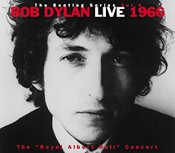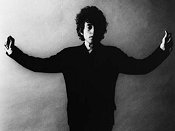MIXED UP CONFUSION: BOB DYLAN, LIVE, 1966 AND THE DEATH OF ROCK 'N' ROLL
By: Gary Pig Gold

 It seems every time Our Boy Bob scores big with a contemporary piece of new work, he feels secure enough to bless us with another timely peak into his vast, remarkable cache of unreleased gems and once-forgotten treasures. Quaintly dubbed THE BOOTLEG SERIES, these excavations into the vaults began a decade ago following the release of the critically acclaimed, Daniel Lanois- produced OH MERCY album. Said inaugural three-CD bundle of out-takes, subtitled "Rare And Unreleased 1961 - 1991," improbably remains one of the more formidable collections of recorded work ever assembled under one box, and has since become an essential part of Dylan's already more than weighty catalog. Ahh my -- if only THE BEATLES ANTHOLOGY had treated its subject matter with the same degree of care, thought and respect.
It seems every time Our Boy Bob scores big with a contemporary piece of new work, he feels secure enough to bless us with another timely peak into his vast, remarkable cache of unreleased gems and once-forgotten treasures. Quaintly dubbed THE BOOTLEG SERIES, these excavations into the vaults began a decade ago following the release of the critically acclaimed, Daniel Lanois- produced OH MERCY album. Said inaugural three-CD bundle of out-takes, subtitled "Rare And Unreleased 1961 - 1991," improbably remains one of the more formidable collections of recorded work ever assembled under one box, and has since become an essential part of Dylan's already more than weighty catalog. Ahh my -- if only THE BEATLES ANTHOLOGY had treated its subject matter with the same degree of care, thought and respect.Similarly, 1997's Grammy-winning (Lanois-produced, perhaps not coincidentally) TIME OUT OF MIND has now enabled the powers-that-may-be to finally issue ? "legally," that is -- one of the most sought-after and, yes, bootlegged albums of all time. Mistakenly labeled "The Royal Albert Hall Concert" ever since it first began appearing in discriminating head shoppes the world over circa 1969, these legendary recordings (actually from the Manchester, England Free Trade Hall) have now been painstakingly restored, respectfully annotated, and lovingly packaged for all to savor and forever cherish as THE BOOTLEG SERIES, VOLUME 4: BOB DYLAN, LIVE, 1966. It is, I hereby unapologetically declare, one of the absolute best records ever released. Anywhere. At any time.
Why, you may well ask? Well, the Dylan of '66 was a man at the indisputable peak of his powers as the [insert your own convenient pigeonhole here] Poet/Laureate of a Generation, Crown Prince of the (Thinking Man's) Hit Parade, or -- my personal favorite -- Snot-headed, Venom-spewing Anti- Rockstar of All Time. However, if truth be told, the Bob Dylan of this period was in fact a man fatally absorbed in his own myth-making, squirming under the pressures of an over-demanding manager, sinking under his obligations to a wholly unsympathetic recording conglomerate, and to top it all off was apparently stuffed to the gills in all manner of dangerously recreational pharmaceutica. Or, as Tony Glover's brilliant liner notes summarize, "Bob was not just burning the candle at both ends ? he was using a blowtorch on the middle."
True enough, 1966 was a tough year for rock 'n' roll idols. Many crashed (Brian Wilson, for one) and several surely burned (John Lennon, most obviously). Dylan, for his part, did manage to snap his neck in two after peeling over the handlebars of his motorcycle that July, but just two months earlier was still in the fiery midst of the Never Ending Tour, Mach One. To the skeptical (at best), resentful (at worst) audiences of western Europe that spring, he had brought not only his trusty old acoustic and some nice folk tunes from his first few albums, but had defiantly snuck onto his tour plane as well a loud, raucous, extremely plugged-in rhythm'n'rock combo from the wilds of Toronto (by way of Arkansas) named The Hawks. This was indeed the proverbial boxing match waiting to happen, for insofar as his reverent disciples throughout the British Isles were concerned the 1966-model Bob was still the poe-faced, freewheelin' baby Guthrie of "Blowin' In The Wind" and "The Times They Are A'Changin'." Electric guitars and Carnaby Street-bright leather jackets? Those were just toys kids played with on that damnable scrapheap called the Top Forty.
Yes, but the times ? not to mention the voice, the instrumentation, and especially the attitude ? had indeed changed since their Boy Wonderful first toured the Empire (captured for posterity, by the way, in the still- magnificent "Don't Look Back" film). And you know, it goes without saying that most people then, as they do now, seem to react to change negatively. Some violently so. THE BOOTLEG SERIES, VOLUME 4, in crisp, digitally reprocessed sound no less, more than demonstrates this.
Just listen to the poor old souls of Manchester on the night of May 17, '66: They may sit politely as Bob impatiently rushes through his acoustic set (preserved on Disc One), but no sooner had The Hawks wheeled their amps onstage and kicked ? literally ? into a defiant "Tell Me, Momma" (with its oh-so-appropriate "I know that you know that I know that you show something is tearing up your mind") that all holy hell began ripping loose. Remember, if you will, that Dylan and his Hawks were the only band on the road that year to come equipped with their very own sound system. Thus freed from having to rely on the puny public address systems of sports arenas and, in the case of England, 100-year-old music halls, Bob & Co. were fiendishly bent on producing some of the loudest rock 'n' roll yet to be heard by man or beast.
Also some of the best: Disc Two's "I Don't Believe You" and "Just Like Tom Thumb's Blues" prove there was no finer band operating in the world at the time, with Robbie Robertson's "mathematical" (as Dylan so aptly called it at the time) guitar work jabbing and slicing with all the poise and finesse of a rusty soup-can lid to the throat. The inimitable Garth Hudson happily adds just the right touch of carnival madness throughout with his hurly-gurdy organ work, but it's most certainly Dylan, front and center, who carries the proceedings throughout -- and carries them clear on up into the stratosphere at times.
 For starters, anyone out there who still thinks the guy can't sing should be strapped down this instant with a pair of headphones and this exquisite rendering of "I Don't Believe You (She Acts Like We Never Have Met)": Most each and every line inexplicably ducks, weaves, then ultimately soars with a totally unparalleled sense of suspense and high drama. In short, This guy sings his effin tail off! (May I remind the still-unconvinced right about here that no less an expert on the subject of vocal pipes as Francis Albert Sinatra was an unabashed admirer of Dylan's singing style (I say, forever resting my case). But that ain't all! With its concluding two salvos, "Ballad Of A Thin Man" and the epochal (definitive recording of, by the way) "Like A Rolling Stone," Dylan not only screeches this album to its wholly apocalyptic end, but pulls off in the process the near impossible: Delightfully terrifying, moronically brilliant, and with a raw, unburdened majesty he ? nor anyone else for that matter ? has yet to recapture, the Hibbing Kid embodies in these conclusive fourteen minutes everything that's still sorely lacking in Popular Music, and pop culture as a (w)hole, these thirty some odd years down the road. In a word or four? Danger. Substance. Permanence and pre-eminence. Need I say more?
For starters, anyone out there who still thinks the guy can't sing should be strapped down this instant with a pair of headphones and this exquisite rendering of "I Don't Believe You (She Acts Like We Never Have Met)": Most each and every line inexplicably ducks, weaves, then ultimately soars with a totally unparalleled sense of suspense and high drama. In short, This guy sings his effin tail off! (May I remind the still-unconvinced right about here that no less an expert on the subject of vocal pipes as Francis Albert Sinatra was an unabashed admirer of Dylan's singing style (I say, forever resting my case). But that ain't all! With its concluding two salvos, "Ballad Of A Thin Man" and the epochal (definitive recording of, by the way) "Like A Rolling Stone," Dylan not only screeches this album to its wholly apocalyptic end, but pulls off in the process the near impossible: Delightfully terrifying, moronically brilliant, and with a raw, unburdened majesty he ? nor anyone else for that matter ? has yet to recapture, the Hibbing Kid embodies in these conclusive fourteen minutes everything that's still sorely lacking in Popular Music, and pop culture as a (w)hole, these thirty some odd years down the road. In a word or four? Danger. Substance. Permanence and pre-eminence. Need I say more?
Some insist that after duly carving his statement with such beautiful cacophony, there was honestly nowhere left for Dylan to go but down and perhaps even out. Others say the man simply paused after that convenient bike wreck to reassess and eventually reinvent himself, as he periodically continues to do to this day (strangely, within eighteen short months of his shoot-out at the ol' Free Trade Hall, Bob had successfully mutated into the solemn, bewhiskered backwoods oracle of JOHN WESLEY HARDING). But perhaps this all goes part and parcel with the risks one ultimately faces when aiming too close to the sun, artistically speaking. BOB DYLAN, LIVE, 1966 captures, as no other record ever has, exactly what it must feel like to peer over that ever-elusive edge, if only for a moment, towards that wondrous splendor known as, sonically speaking at least, The Promised Land. In doing so, it reveals a power and a glory that even this motley bunch of pillheads with their new electric guitars must've been quite awed at having conjured in Manchester that long-ago historic night.
Rock 'n' roll, for one, just doesn't seem brave enough to want to shoot this high anymore, and we are all, believe you me, at a great disadvantage and a great loss because of it. But at least we now have, thanks to Volume 4 of THE BOOTLEG SERIES, a couple of CD's that demonstrate it can be done, naysayers (who is that dolt who cries "Judas!" out at one point between songs?!!) notwithstanding. That said, I repeat: Listen to this record immediately) and often.

